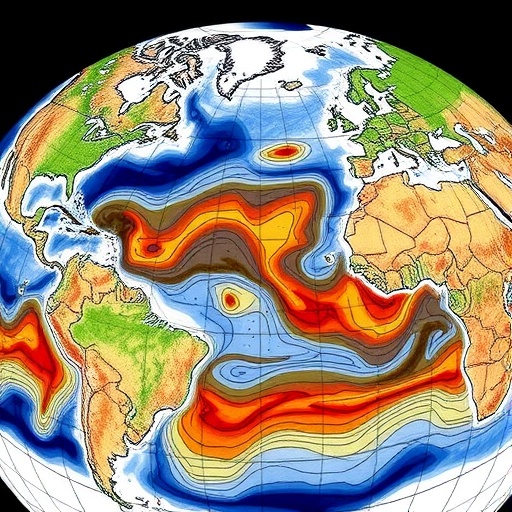In an era marked by growing concern over the stability of Earth’s climatic systems, a groundbreaking study has unveiled compelling evidence that the Atlantic Meridional Overturning Circulation (AMOC)—a crucial component of the global ocean conveyor belt—has exhibited remarkably low variability throughout the entire Holocene epoch. Published in Nature Communications, this research challenges some longstanding assumptions about the sensitivity of ocean circulation patterns to past climate changes and sheds new light on the resilience of the AMOC amid fluctuating environmental drivers over the last 11,700 years.
The AMOC is a vast system of ocean currents that transports warm, salty water from the tropics northward into the North Atlantic, where it cools and sinks, driving a return flow of colder waters at depth. This circulation plays a fundamental role in regulating Earth’s climate, influencing atmospheric circulation, temperature distribution, and even the carbon cycle. Understanding how the AMOC behaved over millennia is vital for projecting its future trajectory in response to ongoing anthropogenic warming.
This extensive study, conducted by Gerber, Lippold, Süfke, and colleagues, leverages sediment core analyses, geochemical proxies, and state-of-the-art climate models to reconstruct the intensity of the AMOC during the Holocene, the current geological epoch that began at the end of the last Ice Age. Their findings reveal a strikingly stable overturning circulation, with limited fluctuations despite major climatic events such as the Holocene Thermal Maximum and the Little Ice Age.
Traditionally, paleoclimate reconstructions have suggested that large-scale climate phenomena—melting ice sheets, freshwater input from glaciers, and abrupt temperature swings—should have induced substantial perturbations in the AMOC. However, this new evidence implies that the AMOC’s overall strength remained resilient to these forcings. The authors argue that this robust persistence may be attributed to a complex balance between atmospheric feedback mechanisms, ocean salinity gradients, and internal ocean dynamics that buffered the circulation against extreme variability.
Central to their methodology was the use of neodymium isotope ratios and benthic foraminifera assemblages preserved within sediment layers. These proxies provide quantitative insights into past water mass sources, pathways, and circulation intensity. By integrating multi-proxy data within a Bayesian statistical framework, the researchers were able to quantify uncertainties and reconcile discrepancies observed in earlier studies based on single proxy records.
Additionally, climate model simulations that incorporated reconstructed freshwater fluxes from melting ice sheets and riverine inputs supported the stability observed in proxy datasets. These simulations demonstrated that, while transient dips in AMOC strength did occur, the circulation self-reinforced and rapidly returned to a near-constant baseline state without entering any prolonged shutdown phases.
The implications of this work extend far beyond academic curiosity. The AMOC’s expected decline in the coming centuries—due to increased freshwater input from Greenland ice melt and altered precipitation patterns—is a key variable in climate projections. If the Holocene stability indeed reflects inherent resistance to perturbations, then future changes might be less abrupt or catastrophic than some models predict. However, the authors caution that the current rate and magnitude of anthropogenic forcing may surpass natural variability thresholds experienced in the past 10,000 years.
Moreover, this research highlights the necessity of high-resolution paleoclimate records to better comprehend complex ocean-atmosphere interactions. The multi-disciplinary approach, combining geochemistry, sedimentology, and numerical modeling, establishes a new benchmark for studying past ocean currents and serves as a critical reference for climate change mitigation strategies.
Notably, the analysis also refines our understanding of regional climate feedbacks. For example, the stability of the AMOC helped maintain relatively stable climate conditions over Europe and North America despite other global perturbations in the Holocene. This finding challenges some theoretical frameworks that linked Holocene climatic oscillations directly to large AMOC fluctuations, prompting a reevaluation of teleconnection mechanisms between ocean circulation and terrestrial climate variability.
By narrowing down the time-resolved range of AMOC variability, the team also illuminated how subtle shifts in ocean temperature and salinity influenced broader biogeochemical cycles. Persistent overturning circulation ensured continued sequestration of atmospheric carbon dioxide into the deep ocean, which in turn regulated greenhouse gas concentrations and global temperatures.
This holistic perspective underscores the importance of the AMOC as both a climate stabilizer and an indicator of anthropogenic impact. It also invites further research into how nonlinearity and feedback loops in ocean dynamics may behave under unprecedented climatic stressors.
The study’s findings resonate deeply with contemporary climate discourse. Discussions around “tipping points” in Earth systems often emphasize potential abrupt disruptions in ocean currents that could accelerate global warming. Yet, the revelation of millennia-long AMOC stability serves as a hopeful counter-narrative, indicating that the ocean conveyor belt may be more robust—though not invulnerable—than previously feared.
Looking ahead, the authors advocate for leveraging emerging technologies such as machine learning and advanced sediment drilling campaigns to extend high-fidelity AMOC reconstructions beyond the Holocene into earlier glacial periods. Such efforts will be essential for mapping the full operational envelope of the AMOC and contextualizing its behavior under different climatic regimes.
In conclusion, this landmark investigation into the Atlantic Meridional Overturning Circulation offers a nuanced understanding of one of Earth’s most influential climate components. By demonstrating low Holocene variability, it reframes ongoing debates about ocean circulation’s sensitivity and resilience to environmental change. These insights provide a crucial foundation for anticipating the future dynamics of the global climate system and fostering adaptive strategies that hinge on the interplay between ocean currents and atmospheric processes.
Subject of Research: Reconstruction and analysis of Atlantic Meridional Overturning Circulation variability throughout the Holocene epoch, utilizing geochemical proxies and climate modeling to assess ocean circulation stability.
Article Title: Low variability of the Atlantic Meridional Overturning Circulation throughout the Holocene
Article References:
Gerber, L., Lippold, J., Süfke, F. et al. Low variability of the Atlantic Meridional Overturning Circulation throughout the Holocene. Nat Commun 16, 6748 (2025). https://doi.org/10.1038/s41467-025-61793-z
Image Credits: AI Generated




